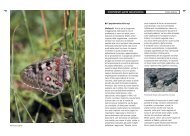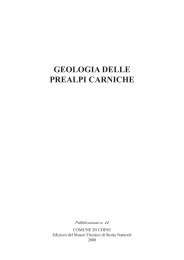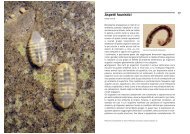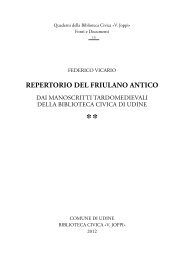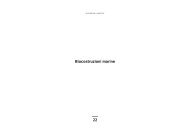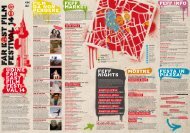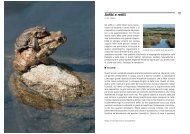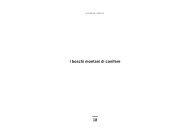Despite its inhospitable appearance and lack of any ... - Udine Cultura
Despite its inhospitable appearance and lack of any ... - Udine Cultura
Despite its inhospitable appearance and lack of any ... - Udine Cultura
Create successful ePaper yourself
Turn your PDF publications into a flip-book with our unique Google optimized e-Paper software.
48<br />
Shells <strong>of</strong> gastropods Iglica vobarnensis, Paladilhiopsis virei <strong>and</strong> Hauffenia subpiscinalis (from top to<br />
bottom, ca. 30x)<br />
Crenobiont species (genera Bythinella <strong>and</strong> Graziana) may enter groundwater<br />
bodies <strong>and</strong> burrow into interstices, probably in search <strong>of</strong> food, <strong>and</strong> therefore<br />
behave as stygophiles. A large number <strong>of</strong> endemic species <strong>of</strong> the genera<br />
Bythiospeum, Iglica, Istriana, Hadziella, Paladilhiopsis <strong>and</strong> Phreatica are<br />
strictly stygobiont, <strong>and</strong> live deep within karstic <strong>and</strong> alluvial underground<br />
networks in northern Italy. Some species, living in Alpine-Dinaric areas, are<br />
exclusive to the eastern Pre-Alps <strong>and</strong> are <strong>of</strong>ten strict endemics (like<br />
Paladilhiopsis robiciana, Phreatica bolei, Hauffenia tellinii <strong>and</strong> Belgr<strong>and</strong>ia<br />
stochi). The area with the fewest species is the Piedmont Alps, with some<br />
endemic species <strong>of</strong> the genera Alzoniella, Iglica <strong>and</strong> Pseudavenionia. The<br />
Apennines host a small number <strong>of</strong> local endemics <strong>of</strong> the genera Pezzolia,<br />
Alzoniella, Pauluccinella, Orientalina, Fissuria <strong>and</strong> Islamia. Exclusive inhabitants<br />
<strong>of</strong> Sardinia are the genera Sardhoratia <strong>and</strong> Sardopaladilhia. Sicily hosts only<br />
one crenobiont species, Islamia cianensis. Thermal waters contain particular<br />
species <strong>of</strong> Bythinella <strong>and</strong> Belgr<strong>and</strong>ia.<br />
■ Polychaetes<br />
Polychaete worms are generally sea animals, <strong>and</strong> only a few species colonise<br />
anchialine coastal waters (l<strong>and</strong>-locked bodies <strong>of</strong> water with a subterranean<br />
connection to the sea), <strong>and</strong> even fewer species are adapted to underground<br />
freshwater. Among them are two stygobiont species <strong>of</strong> great biogeographical<br />
interest.<br />
The nerillid Troglochaetus beranecki is an ancient thalassoid species (that is,<br />
one with marine affinities) originating from members <strong>of</strong> psammon in Tertiary<br />
epicontinental seas, from which it invaded underground freshwater. The<br />
characteristic <strong>of</strong> this species is <strong>its</strong> vast distribution area. In Europe,<br />
Troglochaetus beranecki is found in large rivers (Rhone, Garonne, Rhine,<br />
Weser, Danube, Oder, Elbe), in Finl<strong>and</strong> <strong>and</strong> in Alpine streams. It has also<br />
been found in interstices in river beds <strong>of</strong> Colorado <strong>and</strong> Montana (up to 3050<br />
m), although further molecular analyses are required to establish whether all<br />
these populations are really conspecific. Fewer numbers are found in caves<br />
<strong>of</strong> Switzerl<strong>and</strong>, Germ<strong>any</strong>, Pol<strong>and</strong>, Hungary <strong>and</strong> Romania. In Italy, the species<br />
has recently been found in interstitial environments (Trentino) <strong>and</strong> in caves<br />
(Lessini Hills <strong>and</strong> Carnic Pre-Alps). This distribution is very wide, <strong>and</strong><br />
includes ice-covered areas where underground fauna is minimal if not totally<br />
absent, <strong>and</strong> the rare stygobiont organisms have a remarkable capacity for<br />
adaptation, which enabled them to colonise these areas in post-glacial<br />
periods.<br />
49




